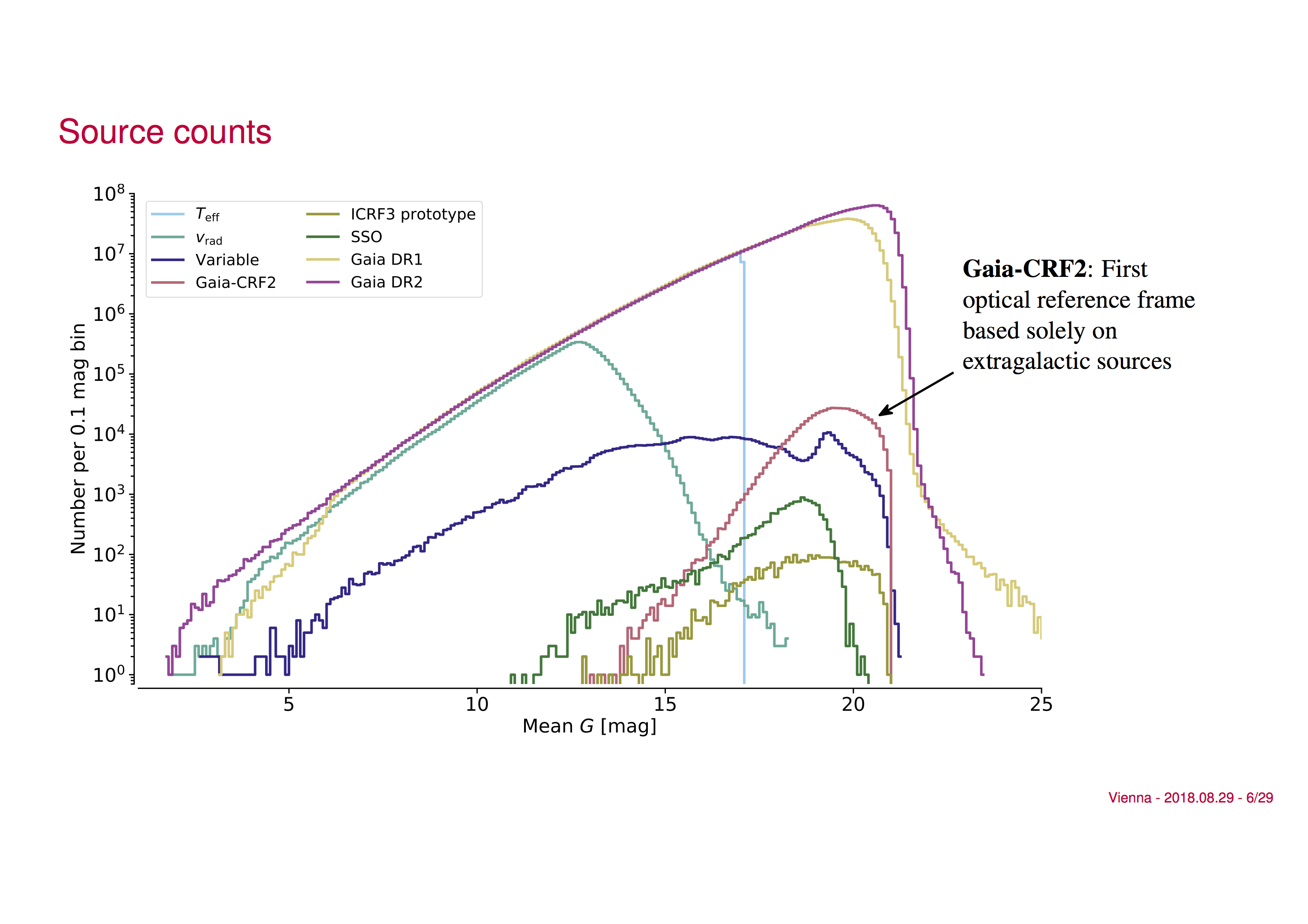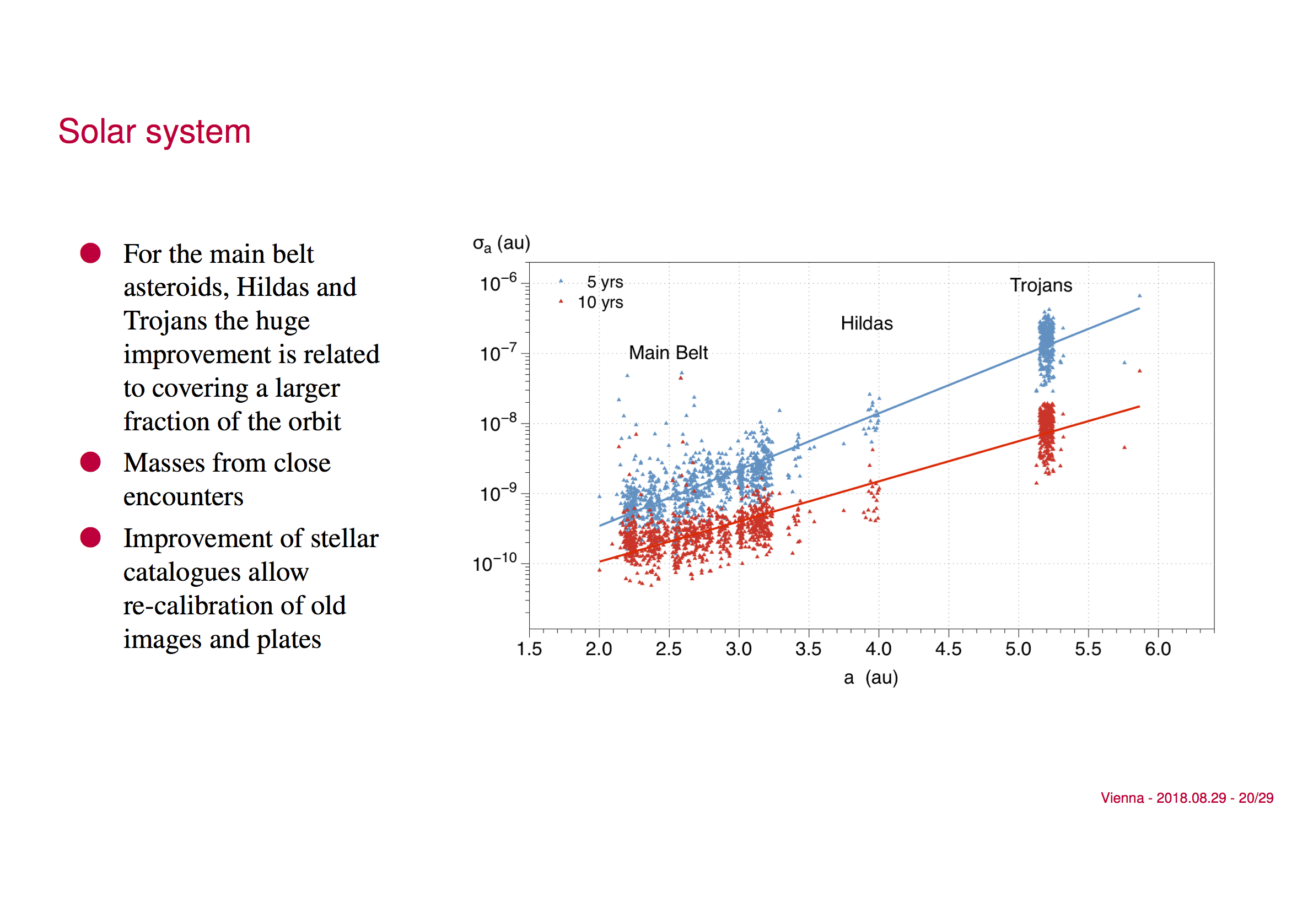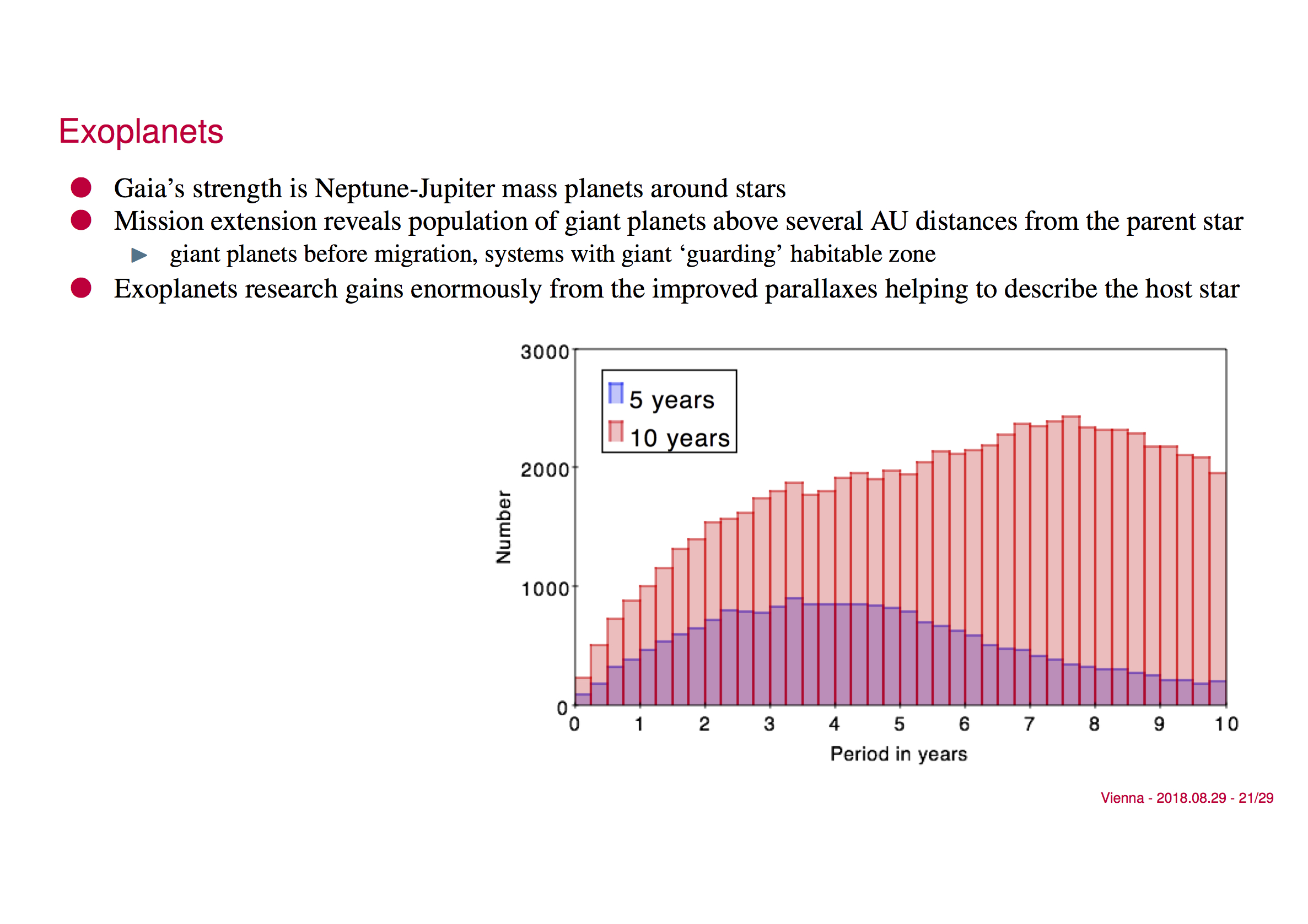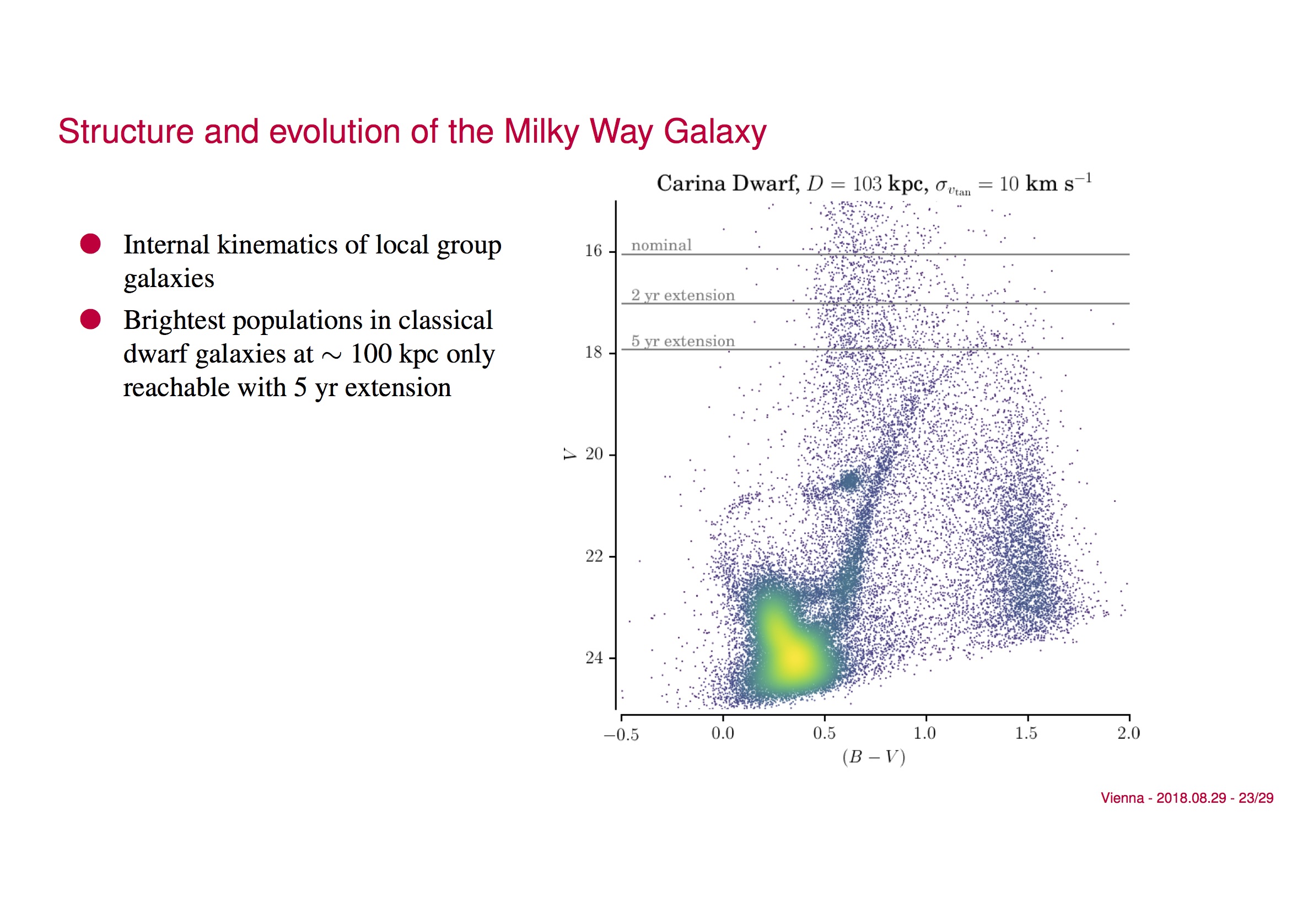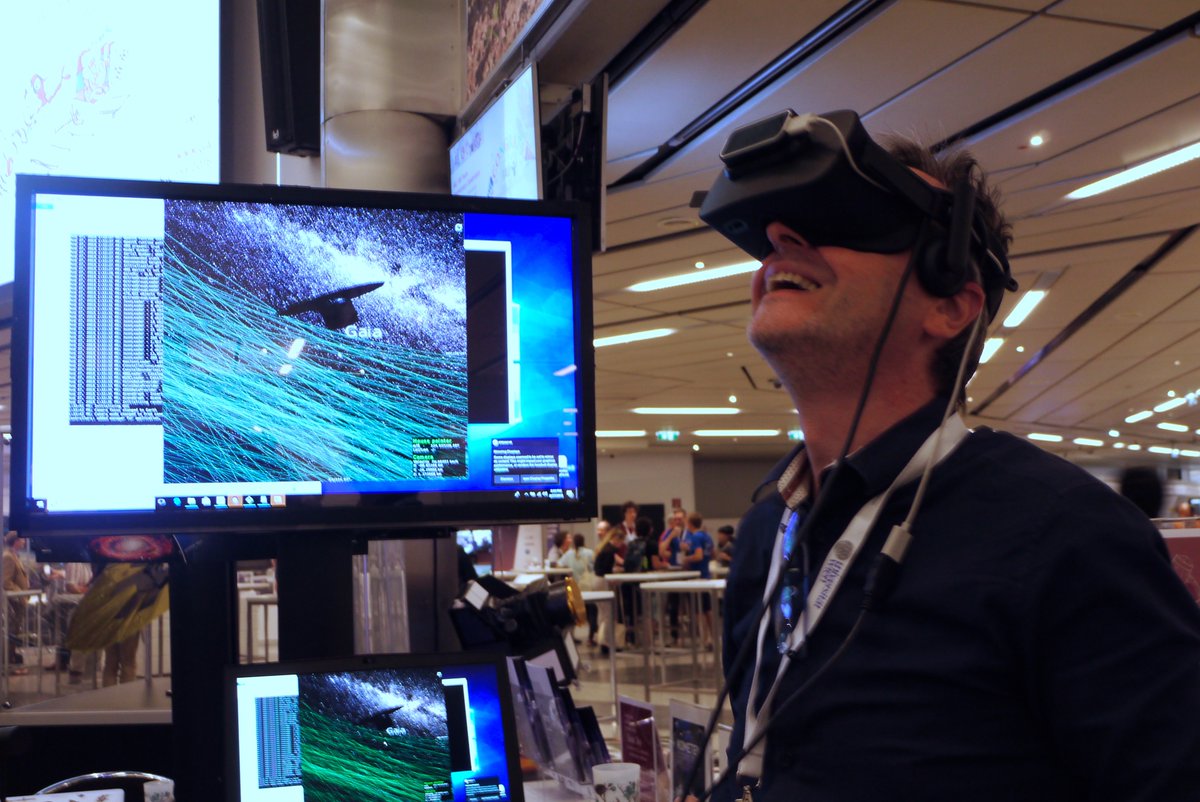IoW_20180911 - Gaia
Image of the Week
Impressions from IAU General assembly
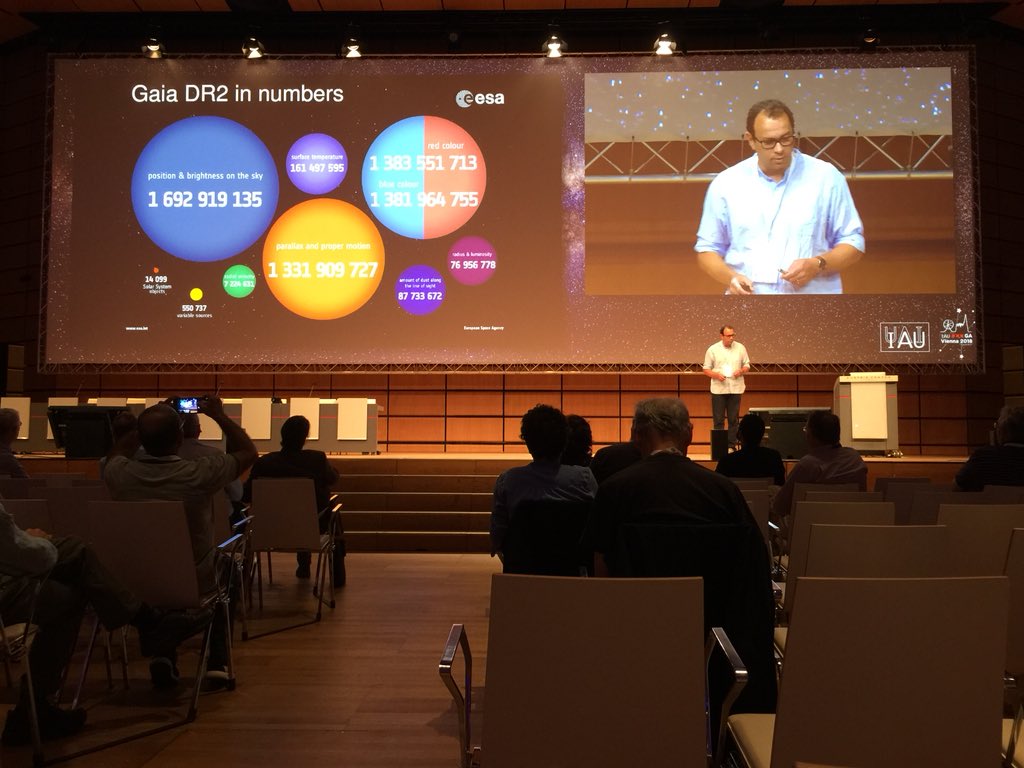
Figure 1: Anthony Brown's presentation at the IAU in Vienna (Image courtesy: D. Montes)
|
The XXXth general assembly of the international astronomical union was held from 20 to 31 August 2018. Division A hosted a Gaia Session in the second week of the meeting, discussing the Gaia Mission Status and the second Gaia data release. Next to this session, several talks in different symposia discussed specifics of Gaia data processing or the use of Gaia data for science. All through the two weeks of the meeting, at the ESA booth demonstrations were given of the use of Gaia data: either how to access the data or how to explore the data in Virtual Reality. It was impressive to see the extent of the use of Gaia data and how powerful the combination of Gaia data with other surveys can be. Here some impressions of Gaia at the IAU in Vienna are given, with downloadable presentations of some of the Gaia session presentations and information on the virtual reality resources demonstrated at the ESA booth. |
|||||||
Gaia Session at the IAUTimo Prusti (Gaia Project Scientist) discussed the status of the Gaia mission. Status of the scientific sub-systems were outlined to show the continued functioning of the spacecraft. Gaia already observed an impressive number of more than 108 billion transits, which is typically more than 300 transits per second and translates to for example more than one trillion astrometric CCD measurements. The current indicated end-of-life of Gaia (which is dependent on the availability of cold gas for keeping an accurate spin rate) is around November 2024. So on top of the nominal mission of 5 years (which ends already in July 2019), Gaia could scan for an additional 5 years given mission extensions are approved. Specifics of the second data release were discussed by Anthony Brown, Chair of the Gaia Data Processing and Analysis Consortium (DPAC). Source counts, performance information and contents of Gaia DR2 were given, along with some very helpful links to online information and tutorials. Also some updates on the future Gaia data releases. Third talk of the Gaia Session was given by Lennart Lindegren, one of the initial proposers of the Gaia mission and current member of the Gaia Science Team. His talk focused on the Gaia DR2 astrometry and gives some considerations on the use of Gaia astrometry. Topics covered include random and systematic errors, quality indicators, and spurious parallaxes. An extended version of his presentation is available from the Gaia DR2 known issues page along with some auxiliary data. Apart from stars, Gaia Data Release 2 also contains asteroids. Paolo Tanga, responsible for the Solar System Objects processing team of Coordination Unit 4 of DPAC, covers this topic in his presentation "Gaia Data Release 2 Solar System Objects Astrometry". Currently asteroids in Gaia DR2 are only included if they have more than 10 transits across the focal plane. For Gaia DR2 this resulted in about 2 million CCD observations. The mean residuals of the Gaia DR2 asteroids are around 1 milliarcsec (mas) while the average mean residuals of the asteroids in the Minor Planet Centre are around 400 mas. While Gaia DR2 contains just over 14,000 asteroids, future releases are expected to contain many, many more. The Gaia Session continued with a presentation by Antonella Vallenari, deputy Chair of Gaia DPAC, with a synthesis on the early science results with Gaia DR2 data. She started off with an overview of the data release papers and the impact Gaia DR2 already has, then continuing to go into more detail to some of the astronomy subjects heavily influenced by Gaia by now: improvements to stellar models, fine details spotted in stellar populations, a new view on the local White Dwarfs, studies on hypervelocity stars, investigations of radii of stars and planets, the estimate of the mass of the Beta Pictoris b planet, research on chemodynamics of the Milky Way, Gaia DR2's new view of the halo, disk perturbations, internal kinematics of globular clusters, and much much more. Then also the Gaia Celestial Reference Frame was discussed by Sergei Klioner, member of the Gaia Science Team. The Gaia Celestial Reference Frame Gaia-CRF2 contains 557,000 QSOs with full astrometric solution and is the first realisation of a global optical reference frame based solely on extragalactic objects. The presentation covers the properties of the celestial reference frame and its relations to the International Celestial Reference Frame 3 (ICRF3). Below are links to the given presentations at the IAU:
Impressions from the various symposiaThe main Gaia presentation outside of the dedicated Gaia Session of Division A was the plenary presentation of the IAUS348 Symposium "21st Century Astrometry: crossing the Dark and Habitable frontiers" given by Anthony Brown on the topic: "The Gaia Mission and its Extension (downloadable here)".
Anthony Brown summarised some specifics on the Gaia Mission that were not covered yet during the Gaia Session, like the Gaia Photometric Alerts and the Gaia Solar System Objects Alerts, the new page describing Gaia DR2 known issues accessible from the general Gaia Data Release 2 page. He mentioned that since April 25 about 240 Gaia DR2 papers appeared on arXiv.org already, and then highlighted some of the results published there. Gaia is in routine operations now and its nominal mission runs until July 2019. To prolong Gaia's life in space, a mission extension is proposed. The science case for this proposal was then highlighted in more detail: "Gaia’s nominal mission will end in mid-2019 already, but the hardware is in good shape to continue and consumables permit 5-year extension." "The scientifically best option for the 5-year extension is to continue scanning the sky. Precision in kinematics and dynamics would increase rapidly with the extension. "Big improvement in orbit precision of Solar System objects, particularly Hildas and Trojans if the Gaia mission is extended from 5 to 10 years" "With extension of the Gaia mission to 10 years, reference frame precision for G=20 stars will stay at 10 milliarcsecs until next IAU centennial in 2119" “5 year extension of the Gaia Mission would improve the exoplanet field from ~30k to ~70k”
Many other talks focused on synergies of Gaia with other missions, or synergies of Gaia and other catalogues available with the opportunity of producing even more powerful catalogues for the communities involved. Many talks described science performed with the use of Gaia data while other talks concentrated on the technical details of the calibration or processing of Gaia Data Release 2.
Presentation "Overview of Photometric Calibration of Gaia DR2" by Dafydd Wyn Evans (Image courtesy: Stefan Jordan).
Virtual reality demonstrations at the ESA boothGaia was one of the prominent missions at the ESA booth, with virtual reality demonstrations offered throughout the full two weeks of the IAU General Assembly meeting. Several virtual reality applications now exist with some connection to the use of Gaia data. Next to these, also 360 degree videos and computer applications exist, allowing for a variety of different ways to explore the Gaia images and Gaia data. One of the virtual reality applications most demonstrated was Gaia Sky. This is an open-source application developed by Gaia DPAC to allow the general public and astronomers to explore the Gaia data. The application allows the user to fly through the stars, see the Gaia DR2 asteroids orbit about the Sun and see the stars move in time. Many features are available to be toggled off or on, like star clusters, proper motion vectors, constellations, propagation in time, planets, orbits of the asteroids, etcetera.
Paolo Tanga flying through the Gaia DR2 asteroid in the Virtual Reality (VR) visualisation Gaia Sky during the 30th IAU in Vienna. Copyright image: ESA – C. Mignone; A. Conigli
Tour through the Gaia DR2 asteroids produced with Gaia Sky (Credit: ESA/Gaia/DPAC)
The second virtual reality application demonstrated is a pilot of the ESAC Science Data Center (ESDC), home to the archives of all ESA Science missions. This application assumes you have several queries of data from the Gaia Archive, and shows these data queries as blocks of data next to your hand. By activating one or more blocks of data, one can explore the data by turning it around or investigating from close-by. Several options are available to toggle on or off the proper motion vectors or the rendering in 2D or 3D. It is a playful way of exploring the data. This application is currently still under development and only a pilot version was used for the demonstrations. In the future, this type of application might become available to explore in an interactive way the Gaia queries performed at the Gaia Archive, but maybe even other queried data from other ESA science archives. Other VR resources, like GaiaVR showcasing the Gaia DR2 sky in colour in a VR environment, are available from the ESA Science & Technology website. Below some 360 degree videos are given which can be used in combination with smartphone or tablet.
360 degree image of the Gaia DR2 sky in colour. Credit: ESA/Gaia/DPAC, ATG Medialab
Parallax and proper motion on the sky - 360° view, produced with Gaia Sky (Credit: ESA/Gaia/DPAC) |
|||||||
|
Credits: ESA/Gaia/DPAC, A. Brown, A. Vallenari, L. Lindegren, S. Klioner, P. Tanga, T. Sagristà, S. Jordan, B. Merín, C. Mignone, A. Conigli, D. Montes [Published: 11/09/2018] |
|||||||
- Removed a total of (31) style text-align:center;
- Removed a total of (19) style text-align:justify;
- Removed a total of (1) align=center.
- Removed a total of (2) border attribute.
- Removed a total of (2) cellpadding attribute.
- Removed a total of (2) cellspacing attribute.
- Converted a total of (3) youtube to youtube-nocookie.
Image of the Week Archive
- Removed a total of (1) border attribute.
- Removed a total of (1) cellpadding attribute.
- Removed a total of (1) cellspacing attribute.








































 Sign in
Sign in
 Science & Technology
Science & Technology
